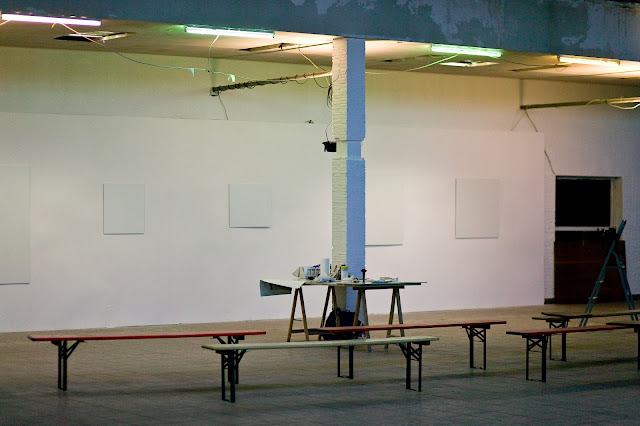Pascal Geiger
Gong Hong Huang
Oleksiy Koval
Kuros Nekouian
Stefan Schessl
Veronika Wenger
Daniel Worsch
Munich 2011/12
The Beautiful Formula Collective is an open group joined by Oleksiy Koval, Kuros Nekouian and Stefan Schessl in 2011. The idea to which the group adresses can be denoted as an attempt to cancel the hierarchic separations in the process of art. We want to find out in wich way a finalized work and its incurrence, as well as the artistic individuality as an activity are interweaved with forms of collective doing and conception. We want to face the process of painting as such und ask about the meaning of formulas and rules, wich feed it and keep it in motion. We want to make the process of art tangible and transparent as a test assembly. We want to set free the curiosity for understanding painterly test assemblies. Eventually such an understanding can only emerge, if the onlooker leaves the position as an external observer and exposes himself or herself to the participation in the process oft art itself. We imagine that the forms of expression of those processes hereby gain the open character of an enactment. The constellations deriving from such a test assembly are to be documented and fixed in the form of a compendium.
An outstanding element of the process of painting is the rhythm in which the fabrication of an art work is accomplished. Rhythmical structures generate the process of painting as a more or less determinated movement in space and time. It gives form to the application of colours on surfaces. The rules of such a shaping, its sequence and number can be set and handled as rhythmical motives like, for example, 2,3,1 or 1,1,2. Here the 1 is to be conceived as a basal unity of movement that can be freely chosen. Picture plane: To gain certainty in dealing with different tempos while applying colours, the picture plane is divided in parts through numeric impulses that we call “meter” (1/4, 1/9, 1/16…).
How can such structures and motives of the process of art be performed and presented in a live environment, in front of the audience? The works to be generated are produced in a set point in time on empty image carriers already at hand. Working on them can be executed both alone as well as in a group. Hereby different rhythmical motives, meters, colours and materials as well as the entry of the persons involved are joined, so as to generate a constant composition, however implemented in a variable way.
The Beautiful Formula Collektive ist eine offene Gruppe, zu der sich Oleksiy Koval, Kuros Nekoulian und Stefan Schessl 2011 zusammengetan haben. Die Idee, der sich die Gruppe widmen will, lässt sich als ein Versuch kennzeichnen, die hierarchischen Trennungen des Kunstprozesses aufzuheben. Wir wollen herausfinden, auf welche Weise ein abgeschlossenes Werk und der Prozess seines Entstehens, wie die künstlerische Individualität als eine Tätigkeit mit Formen kollektiven Tuns und Auffassens verwoben ist. Wir wollen uns dem Malprozess als solchem zuwenden und nach der Bedeutung von Formeln und Regeln fragen, die ihn in Gang setzen und in Bewegung halten. Wir wollen den Kunstprozess als eine Versuchsanordnung erfahrbar und durchsichtig machen. Wir wollen die Neugierde auf das Verständnis malerischer Versuchsanordnungen freisetzen. Zuletzt kann sich ein solches Verständnis nur ergeben, sobald der Betrachter die Position des externen Beobachters verlässt und sich der Teilnahme am Prozess der Kunst selbst aussetzt. Wir stellen uns vor, dass die Ausdrucksformen dieses Prozesses auf diese Weise den offenen Charakter einer Aufführung gewinnen. Die Konstellationen, die sich aus einer solchen Versuchsanordnung ergeben, wollen wir dokumentieren und in der Form eines ‚Handbuchs’ festhalten.
Ein herausragendes Element des Malprozesses ist der Rhythmus, in dem sich die Herstellung eines Werkes vollzieht. Rhythmische Strukturen generieren den Malprozess als eine mehr oder minder geregelte Bewegung in Raum und Zeit. Er gibt dem Anbringen von Farben auf Flächen eine Form. Die Regeln derartiger Formgebung, ihre Folge und ihr Anzahl lassen sich festlegen und als rhythmische Motive wie z.B. 2,3,1 oder 1,1,2 handhaben. Hierbei hat man sich 1 als frei zu wählende basale Bewegungseinheit vorzustellen. Fläche: Um Sicherheit im Umgang mit unterschiedlichen Tempi beim Anbringen von Farben zu gewinnen, wird die Fläche durch zahlenmäßige Impulse, von uns Metrum genannt (1/4, 1/9, 1/16…), in Teile zerlegt.
Wie lassen sich derartige Strukturen und Motive des Kunstprozesses in einer Live-Situation, vor Publikum zur Darstellung und zur Aufführung bringen? Die herzustellenden Werke werden zu einer festgesetzten Zeit auf vorhandenen leeren Bildträgern verfertigt. Es werden Bildträger in unterschiedlichen Formaten verwendet. Die Arbeit an ihnen kann sowohl allein als auch in der Gruppe erfolgen. Dabei werden unterschiedliche rhythmische Motive, Metren, Farben und Materialien, sowie die Einsätze der beteiligten Personen zusammengeführt, so dass eine konstante Komposition entsteht, die aber variabel realisiert werden muss.
Oleksiy Koval, Prof. Bernhard Lypp, Kuros Nekouian, Stefan Schessl
München, den 29.1.2012

Hello all
ReplyDeleteThe text sound good, very interesting.
go further,
Werner Windisch